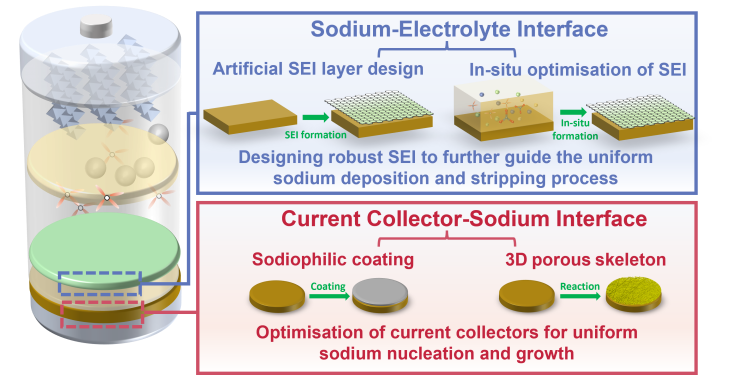 PDF(3721 KB)
PDF(3721 KB)


Critical Issues and Interfacial Design on the Anode Side for Anode-Free Sodium Batteries
Jiawen Dai, Chunlin Xie, Rui Zhang, Huanhuan Li, Haiyan Wang
Prog Chem ›› 2025, Vol. 37 ›› Issue (4) : 551-563.
 PDF(3721 KB)
PDF(3721 KB)
 PDF(3721 KB)
PDF(3721 KB)
Critical Issues and Interfacial Design on the Anode Side for Anode-Free Sodium Batteries
Compared to lithium-ion batteries,sodium-ion batteries have greater advantages in terms of resources,cost,safety,power performance,low-temperature performance,and so on. However,the energy density of sodium-ion batteries is relatively low. To explore broader application prospects,the development of high-specific energy sodium batteries has become a research hotspot in both academia and industry. The anode is considered the key bottleneck constraining the development of the sodium battery industry due to limitations such as the inability of graphite to serve as sodium anodes and the high cost,low Coulombic efficiency,and poor kinetics of mainstream hard carbon materials. In recent years,anode-free sodium batteries (AFSBs) have garnered widespread attention due to their advantages in energy density,process safety,and overall battery cost. However,AFSBs generally show rapid capacity loss due to the rupture of the solid-electrolyte interphase (SEI) layer,increased chemical side reactions,serious dendrite growth and the formation of dead sodium. As the AFSBs operate,active sodium is continuously consumed without additional metallic sodium to replenish it,leading to poor cycling performance and failure of AFSBs. These issues can be attributed to the following characteristics: the high reactivity of sodium,non-uniform nucleation and huge volume expansion. To elucidate the strategies for promoting dendrite-free growth on the anode side of AFSBs,this review focuses on the current collector-sodium interface and sodium-electrolyte interface,including the design of sodiophilic coatings,porous skeleton structure to regulate the sodium nucleation process,and the construction of robust SEI interface,which further guides the homogeneous sodium deposition and stripping process. This systematic review is expected to draw more attention to anode-free configurations and bring new inspiration to the design of high-specific energy batteries.
Contents
1 Introduction
2 Factors affecting sodium deposition on the anode side
2.1 High reactivity of sodium
2.2 Inhomogeneous sodium deposition
2.3 Volumetric deformations
3 Critical differences between sodium and lithium
4 Interface design principles and strategies
4.1 Design principles
4.2 Homogeneous nucleation regulation at the current collector-sodium interface
4.3 Formation of robust SEI at the sodium-electrolyte interface
5 Conclusions and prospects

anode-free sodium batteries / uniform deposition / dead sodium / sodiophilic / porous skeleton structure / artificial SEI
| [1] |
|
| [2] |
|
| [3] |
(陈锦攀, 陈春晓, 胡志刚. 电池, 2019, 49(1): 79.).
|
| [4] |
|
| [5] |
(闫金定. 航空学报, 2014, 35(10): 2767.).
|
| [6] |
|
| [7] |
|
| [8] |
|
| [9] |
|
| [10] |
|
| [11] |
|
| [12] |
|
| [13] |
|
| [14] |
|
| [15] |
(何菡娜, 王海燕, 唐有根, 刘又年. 化学进展, 2014, 26(4): 572.).
|
| [16] |
|
| [17] |
|
| [18] |
|
| [19] |
|
| [20] |
|
| [21] |
|
| [22] |
(张思伟, 张俊, 吴思达, 吕伟, 康飞宇, 杨全红. 化学学报, 2017, 75(2): 163.).
|
| [23] |
(岳昕阳, 马萃, 包戬, 杨思宇, 陈东, 吴晓京, 周永宁. 物理化学学报, 2021, 37(12): 2.).
|
| [24] |
|
| [25] |
|
| [26] |
|
| [27] |
|
| [28] |
|
| [29] |
|
| [30] |
|
| [31] |
|
| [32] |
|
| [33] |
|
| [34] |
|
| [35] |
|
| [36] |
|
| [37] |
|
| [38] |
|
| [39] |
|
| [40] |
|
| [41] |
|
| [42] |
|
| [43] |
|
| [44] |
|
| [45] |
|
| [46] |
|
| [47] |
|
| [48] |
|
| [49] |
|
| [50] |
|
| [51] |
|
| [52] |
|
| [53] |
|
| [54] |
|
| [55] |
|
| [56] |
|
| [57] |
|
| [58] |
|
| [59] |
|
| [60] |
|
| [61] |
|
| [62] |
|
| [63] |
|
| [64] |
|
| [65] |
|
| [66] |
|
| [67] |
|
| [68] |
|
| [69] |
|
| [70] |
|
| [71] |
|
| [72] |
|
| [73] |
|
| [74] |
|
| [75] |
|
| [76] |
|
| [77] |
|
| [78] |
|
| [79] |
|
| [80] |
|
| [81] |
|
| [82] |
|
| [83] |
|
| [84] |
|
/
| 〈 |
|
〉 |